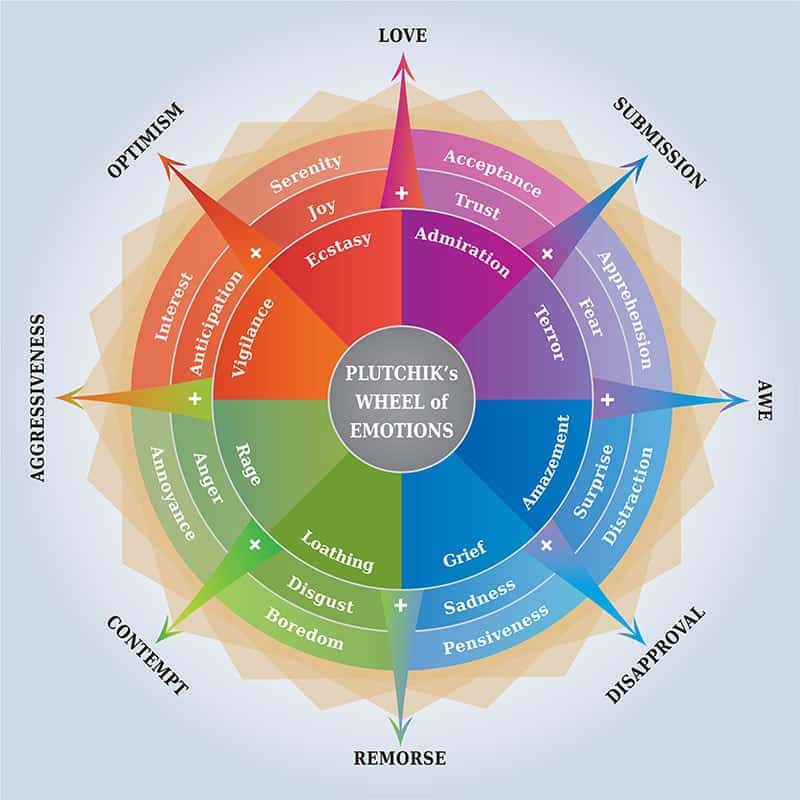Learning to understand and process your emotions in a healthy way is a vital part of maintaining your mental health. Plutchik’s wheel of emotions is a powerful tool in understanding basic emotions, where they come from, and how they relate to each other.
Once you understand these primary emotions, you can assess how and why you’re feeling the way that you are.
Let’s take a look at the wheel of emotions and see how you can apply it to your own life.
Plutchik’s Wheel of Emotions
Psychologist Robert Plutchik created a diagram to help people understand what he considered the 8 basic emotions: disgust, fear, anger, anticipation, joy, sadness, trust, and surprise.
He believes that all other emotions can be traced back to these 8 emotions and they all exist on a continuum. The diagram takes the shape of an ice cream cone, and when you unfold it, you get the wheel of emotions.
Each primary emotion has an opposite, and you can see it on the other side of the wheel. The primary emotions are the ones in the center of each petal. For example:
- Joy opposes sadness
- Fear opposes anger
- Anticipation opposes surprise
- Disgust opposes trust
You’ll see on the wheel that there are emotions without color on the outer edge. Those are a blend of the two emotions on either side. They’re a combination of emotions.
For example:
- Optimism is a combination of joy and anticipation
- Submission is a combination of trust and fear
- Remorse is a combination of disgust and sadness
You’ll also see that the colors of the petal get darker as you get closer to the center. The intensity of the color corresponds with the intensity of the emotion.
On the Plutchik wheel of emotions:
- Ecstasy is more intense than joy, joy is more intense than serenity
- Admiration is more intense than trust, trust is more intense than
- Terror is more intense than fear, fear is more intense than apprehension
- Amazement is more intense than surprise, surprise is more intense than distraction
- Grief is more intense than sadness, sadness is more intense than pensiveness
- Loathing is more intense than disgust, disgust is more intense than boredom
- Rage is more intense than anger, anger is more intense than annoyance
- Vigilance is more intense than anticipation, anticipation is more intense than interest

Using the Feelings Wheel
So how can you use Plutchik’s wheel in your own life?
Untangling what emotions you experience will help you refrain from making emotional responses. With a higher emotional intelligence, you can make rational decisions that avoid explosive confrontation.
Once you identify the emotions you are feeling, you can find their source and confront the problem at its root, rather than reacting in distress.
Using the feelings wheel, let’s take a look at how the core emotions of joy, trust, fear, surprise, disgust, anger, anticipation, and sadness relate to each other in some examples.
Case Study 1: Birthday
Your birthday is coming up. You know your partner has something up their sleeve because they keep hinting at it, but you don’t know what, and you absolutely hate surprises. You’re someone that likes to know what is going to happen so you can be in control of the situation, but this is completely out of your hands.
You come back to your apartment at the end of the day, not sure what you’ll come back to.
You open the door and see that they have a candle-lit dinner with your favorite homemade meal, a bouquet of roses, and a wrapped present at your place setting.
Best of all, your love language is acts of service and they cleaned your apartment and did all the dishes!
What emotions did you go through?
Here’s a breakdown of what you most likely experienced, based on your personality.
You started with apprehension. The feeling wasn’t intense enough to be fear, but you didn’t like not having control.
Once you accepted that your partner was going to do something for you, you moved into the secondary emotion of submission, which is a combination of acceptance and apprehension.
Once you opened your apartment door, you went from apprehension to surprise, experiencing a bit of the middle emotion of awe. Once you realized that they cleaned and did the dishes, you might have intensified the emotion all the way to amazement, especially if this is out of character for them.
Cast Study 2: 1 on 1 Meeting
Your boss emails you asking for a private meeting on Friday. You have no idea what this meeting is about, but a Friday meeting is never a good sign. You spend all week wondering what it could be about and casually searching on Indeed for a new job, expecting the worst.
You go into the meeting and take a seat. Your boss starts to talk about how well you’ve been doing lately and how there’s a big project coming up that he wants you to lead. If you agree to take on the new responsibility, he wants to change your job title and a pay raise. You agree.
Let’s unpack the emotions experienced here based on the wheel of emotions.
Once you get that email, you have an interest in the situation.
Once you realize it’s happening on Friday, the emotion intensifies to anticipation.
As you hem and haw all week, wondering what you could have done to deserve this, wondering if you’ll be fired, you have a combination of anger and anticipation and you might lash out with aggressiveness with the people around you.
Right as you open the door, your emotions are heightened all the way to vigilance. You are sweating, anxious, and shaking.
Once you realize you’re getting a promotion, you jump across the wheel to amazement.
As you learn more about the position, you have a combination of joy and anticipation, which is optimism. You’re a bit nervous about what’s to come, but you’re excited about the possibilities.
Plutchik’s wheel is only a starting point to accessing greater emotional intelligence. You decide how to take your next steps now that you better understand your emotional state.
Using a combination of emotional and logical choices, you can decide where to go from there.

Understanding the Wheel of Emotions Gives You Control
Emotions can sometimes overwhelm us. When we feel an emotion too strongly, it’s hard to take action, because we can’t think logically about how to take our next steps. Taking the time to understand your emotions will give you the opportunity to process them in a healthy way.
Using the wheel of emotions will give you the tools you need to understand the root of your feelings and how they relate to one another.
If you’re still having problems assessing overwhelming emotions, talking with a therapist can be extremely helpful. It’s their job to give you the tools you need to handle your emotions in a healthy, productive, and safe way.
Published in Featured Articles, HealthAuthor, Artist, Photographer.
Sarah Margaret is an artist who expresses her love for feminism, equality, and justice through a variety of mediums: photography, filmmaking, poetry, illustration, song, acting, and of course, writing.
She owns Still Poetry Photography, a company that showcases her passion for capturing poetic moments in time. Instead of poetry in motion, she captures visual poetry in fractions of a second, making cherished keepsakes of unforgettable moments.
She is the artist behind the Still Poetry Etsy shop, which houses her illustrations and bespoke, handmade items. She is the author of intricacies are just cracks in the wall, a narrative poetry anthology that follows a young woman discovering herself as she emerges from an abusive relationship.





